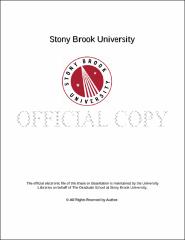| dc.identifier.uri | http://hdl.handle.net/11401/77416 | |
| dc.description.sponsorship | This work is sponsored by the Stony Brook University Graduate School in compliance with the requirements for completion of degree. | en_US |
| dc.format | Monograph | |
| dc.format.medium | Electronic Resource | en_US |
| dc.language.iso | en_US | |
| dc.publisher | The Graduate School, Stony Brook University: Stony Brook, NY. | |
| dc.type | Dissertation | |
| dcterms.abstract | This dissertation consists of three essays dealing with issues related to patent licensing from a game-theoretic perspective. In the first essay, Chapter 2, the problem facing an inventor who holds the patent of a technology that can potentially be used to reduce the costs of firms in a given industry is considered. The technology's ability to cut firms' costs depends on a use for it being discovered, and the inventor has the option of trying or not to discover the use before licensing the technology to the firms. In this context, two main questions are addressed. First, which alternative should the inventor choose? Second, how does this decision affect the diffusion of the technology in the industry? Interestingly, the inventor may not try to discover the use of the technology, even when trials are costless. Moreover, this decision may lead to a higher diffusion of the technology than its alternative. The second essay, Chapter 3, considers a patent licensing model in which an outside inventor holds the patent of a cost-reducing technology that can be licensed to heterogeneous Cournot duopolists, one being more efficient in production---in the sense of operating at lower costs---than the other. Could the licensing of the technology---when carried optimally from the patentee's point of view---reduce the efficiency gap between these firms? It will be seen that, under the assumptions maintained in the chapter, the answer to this question is no. Finally, the third essay, Chapter 4, studies a model in which two patentees engage simultaneously in licensing. The technologies owned by these inventors are substitutes---i.e., both allow the production of the same good. However, one technology is at least as efficient as the other. Allowing for competition between patent owners is a major departure from the literature. What are the implications of this departure? More specifically, what is the impact of competition on a patentee's licensing behavior? Is it possible for the owner of a relatively inefficient technology to survive competition with a stronger rival patentee? In general lines, the answer to the first question is: the introduction of one competitor may lead to a significant increase in the number of licenses sold by a patentee; whereas the answer to the second question is: yes, however, with a small probability. Each of the chapters mentioned above is an original contribution to the theoretical literature on patent licensing. The chapters are mutually independent and each is organized in the format of a research paper. In particular, each chapter contains its own introduction and conclusion. An introduction to the dissertation is provided in Chapter 1; Chapter 5 concludes the dissertation with a brief review of the main findings. | |
| dcterms.available | 2017-09-20T16:52:39Z | |
| dcterms.contributor | Tauman, Yair | en_US |
| dcterms.contributor | Brusco, Sandro | en_US |
| dcterms.contributor | Dubey, Pradeep | en_US |
| dcterms.contributor | Neyman, Abraham. | en_US |
| dcterms.creator | Dutra Badia, Bruno | |
| dcterms.dateAccepted | 2017-09-20T16:52:39Z | |
| dcterms.dateSubmitted | 2017-09-20T16:52:39Z | |
| dcterms.description | Department of Economics. | en_US |
| dcterms.extent | 51 pg. | en_US |
| dcterms.format | Application/PDF | en_US |
| dcterms.format | Monograph | |
| dcterms.identifier | http://hdl.handle.net/11401/77416 | |
| dcterms.issued | 2015-12-01 | |
| dcterms.language | en_US | |
| dcterms.provenance | Made available in DSpace on 2017-09-20T16:52:39Z (GMT). No. of bitstreams: 1
DutraBadia_grad.sunysb_0771E_12452.pdf: 486817 bytes, checksum: ab7382de859b7bf880b586a7e492573c (MD5)
Previous issue date: 1 | en |
| dcterms.publisher | The Graduate School, Stony Brook University: Stony Brook, NY. | |
| dcterms.subject | Economics | |
| dcterms.subject | Cournot Competition, Patent Licensing, Process Innovation | |
| dcterms.title | Essays on Patent Licensing | |
| dcterms.type | Dissertation | |

